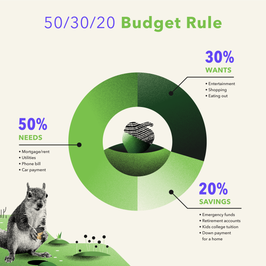Checking vs Savings Account: What's the Difference?

Bank accounts come in different varieties, suited for different needs and different purposes; for example, direct deposit accounts and money market accounts.
While you may not be familiar with those two terms, you probably are familiar with checking accounts and savings accounts. They’re two of the most common and popular types of bank accounts out there. But while checking and savings accounts are often discussed together, and offered by the same banks, there are important differences between the two accounts that individuals should understand.
Below, we take a look at checking accounts and savings accounts so that you can better understand the differences between them. We also answer some common questions about each so that you can make a more informed decision about where you keep your money.
What is a savings account?
A savings account is a type of account offered by banks, credit unions, and some other financial institutions, which allows a customer to deposit money in order to keep the money safe and secure. Though there are limitations to bear in mind, money can typically be withdrawn from a savings account as necessary, regardless of purpose.
Savings Account Accessibility
Though savings account holders can typically access their money by visiting the institution holding their funds, most savings accounts do not supply bank cards, debit cards, or checks. This can sometimes make it difficult to access your money quickly and easily.
Additionally, most banks will limit the number of transactions or withdrawals that you can make from your savings account. Regulation D, a rule imposed by the Federal Reserve Board, which was implemented to ensure that banks hold proper reserves, allows a bank to charge you a fee if you were to make more than six withdrawals or transfers in a single month. This makes savings accounts better suited for money that is not expected to be spent in the short term. It can be used to build an emergency fund or to save for financial goals.
Savings Account Interest Rates
In exchange for a deposit, savings account holders earn interest on the funds kept in their account. Interest rates on savings accounts vary substantially depending on a number of factors, including the bank or institution and the underlying credit market.
The interest rates paid by the most established and well-known banks tend to be very low, often averaging between 0.01 and 0.10 percent. In 2019, the average savings account paid an interest rate of 0.09 percent. Some online banks, however, pay interest rates that are much higher than those traditional banks, reaching as high as 1.50 percent or more.
Minimum Balances for Savings Accounts
Though some banks and credit unions will allow you to open a savings account without a minimum deposit, most institutions do have a threshold which you must meet to open an account. This can vary substantially from bank to bank. If you open a savings account and then your balance drops below this daily minimum, you may find that you are responsible for paying a monthly fee.
Additionally, some savings accounts may offer higher interest rates to account holders who meet certain deposit limits.
Savings Account Limits
Generally speaking, you can keep as much money in your savings account as you choose. There are no maximum limits and savings accounts are FDIC-insured up to $250,000.
What is a checking account?
Like a savings account, a checking account is a type of account offered by banks, credit unions, and some other financial institutions. Like a savings account, checking accounts are designed to pay interest and security to the funds that they hold. Unlike savings accounts, checking accounts are generally more accessible, and used for daily spending needs.
Checking Account Accessibility
Generally speaking, funds held within a checking account may be accessed by a customer at any time. This is typically done by using a personal check, or using a debit card for an ATM withdrawal, though an account holder may also visit their bank directly to withdraw funds as well.
Although savings accounts are subject to transaction limits as imposed by Regulation D, checking accounts are not. This makes checking accounts better suited for money that is intended to be spent in the short term.
Checking Account Interest Rates
Like savings accounts, checking accounts pay interest on the funds held within them. The interest rates paid by most banks does tend to be lower than for savings accounts, though. In 2019, the average interest rate offered by most banks was 0.04 percent.
Minimum Balances for Checking Accounts
Like savings accounts, most banks will typically require you to deposit a certain minimum balance in order to open a checking account. You may then need to maintain a minimum daily balance or be subject to a monthly account fee. This account fee can often be waived if you enable direct deposit into your checking account.
Checking Account Limits
Generally speaking, most checking accounts will not have a maximum limit as to how much money you can hold in your account at any given time. Like savings accounts, checking accounts are FDIC-insured up to $250,000.
How are checking and savings accounts different?
As noted above, checking accounts and savings accounts share a number of similarities and differences. The table below explains these differences:
|
Savings Account |
Checking Account |
|
|
Used For |
Saving money |
Money you plan to spend |
|
Pays Interest? |
Always |
Often, but not always |
|
Interest Rates |
Higher interest rates. Average of 0.09% (2019). |
Lower interest rates. Average of 0.04% (2019). |
|
Accessibility |
Less accessible. Often requires visiting the bank. |
More Accessible. Checks, debit cards, etc. |
|
Withdrawal Limits |
Typically 6 transactions per month |
No transaction limits |
|
Minimum Balance |
Yes, determined by the bank. |
Yes, determined by the bank. |
|
Maximum Balance |
Not typical |
Not typical |
|
FDIC-insured? |
Yes, up to $250,000. |
Yes, up to $250,000. |
Which account is right for you?
Ultimately, this isn’t a question of either/or. Many people have both a checking account and a savings account, in order to take advantage of the unique benefits offered by each.
Knowing which account should hold what money will ultimately depend on the plans that you have for that money.
For example, you should likely put your money in a checking account if you plan on spending it in the near term, such as for your regular expenses and for paying bills. This might include any regular recurring expenses, such as utilities, your rent or mortgage, subscriptions, groceries, entertainment, debt payments, and other monthly expenses. This is because the primary reason for a checking account is to facilitate payments.
The drawback, of course, is that money held in a checking account will earn little in the form of interest.
On the other hand, you should likely keep your money in a savings account if you do not plan to spend it in the short term. A savings account will keep your money safe, while also offering at least some growth in the form of interest. By separating your money from your checking account, it is also possible that you will prevent yourself from mindlessly spending money that you want to save.
If you have a long time before you need to use your savings, wish to maximize growth, and can tolerate some risk, it may also be wise to keep a portion of your savings in an investment account, where you can invest in stocks, bonds, and other assets. Typically, investing is better suited to long-term goals, such as retirement. (Acorns offers both regular and retirement investment accounts.)
This material has been presented for informational and educational purposes only. The views expressed in the articles above are generalized and may not be appropriate for all investors. The information contained in this article should not be construed as, and may not be used in connection with, an offer to sell, or a solicitation of an offer to buy or hold, an interest in any security or investment product. There is no guarantee that past performance will recur or result in a positive outcome. Carefully consider your financial situation, including investment objective, time horizon, risk tolerance, and fees prior to making any investment decisions. No level of diversification or asset allocation can ensure profits or guarantee against losses. Article contributors are not affiliated with Acorns Advisers, LLC. and do not provide investment advice to Acorns’ clients. Acorns is not engaged in rendering tax, legal or accounting advice. Please consult a qualified professional for this type of service.









